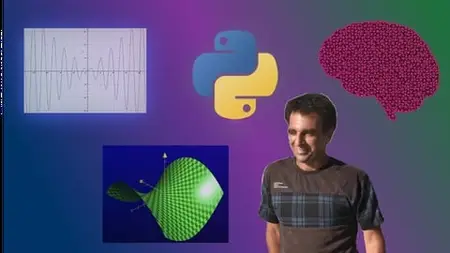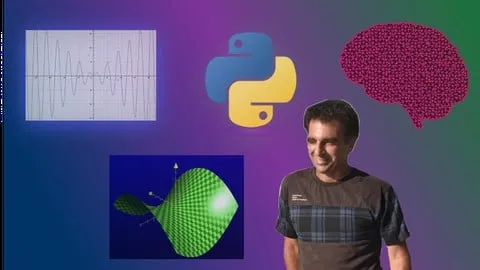Python Calculus For Data Science And Machine Learning
Published 8/2025
MP4 | Video: h264, 1920x1080 | Audio: AAC, 44.1 KHz
Language: English | Size: 1003.32 MB | Duration: 3h 27m
Published 8/2025
MP4 | Video: h264, 1920x1080 | Audio: AAC, 44.1 KHz
Language: English | Size: 1003.32 MB | Duration: 3h 27m
Build a solid calculus foundation with Python to power your machine learning journey
What you'll learn
Understand and apply fundamental calculus concepts (limits, derivatives, multivariable gradients, and integrals)
Use Python libraries such as NumPy, SymPy, Matplotlib, and SciPy to perform symbolic and numerical calculus computations and visualize mathematical concepts
Connect calculus to real-world applications by analyzing cost functions, optimization problems, probability distributions, and data-driven models
Develop problem-solving skills by combining calculus theory with Python coding to explore and implement techniques such as gradient descent, curve fitting, and
Requirements
Basic Python knowledge (variables, functions, loops, lists/arrays). You don’t need to be an expert programmer.
High school-level math (algebra, functions, basic graphing). No prior calculus experience is required — we’ll build it step by step.
Computer with internet access and ability to run Jupyter Notebook/Google Colab (free, no installation needed).
Curiosity and motivation to connect math with real-world data science and machine learning.
Description
Unlock the power of calculus with Python, the essential math skill for data science, machine learning, and real-world problem solving. This comprehensive course is designed not only to teach you calculus concepts but to help you apply them directly through Python programming — no dry theory, only practical, hands-on learning.Whether you’re a student, developer, or aspiring data scientist, this course will guide you step-by-step from the fundamentals of functions and limits through derivatives, integrals, and multivariable calculus — all reinforced by coding exercises and real-world applications.What You’ll Learn:Core Calculus Concepts: Functions, limits, continuity, derivatives, integrals, optimization, and the fundamentals of multivariable calculus explained clearly with interactive Python examples.Python for Math: Master libraries like SymPy for symbolic math, NumPy for numerical calculations, and Matplotlib for plotting calculus concepts visually.Applied Problem Solving: Use calculus to solve real problems — from rate of change in physical systems to area under curves and optimization challenges.Foundations for Machine Learning: Understand how calculus underlies machine learning algorithms — gradients, cost functions, and optimization techniques — giving you a head start on ML development.Project-Based Learning: Build mini projects such as a derivative calculator, integral solver, and a simple gradient descent optimizer to solidify your understanding.Bonus: Deploying a Shiny App: Learn how to create and deploy an interactive web app using Shiny to showcase your calculus projects and Python computations, making your work accessible and impressive for presentations, portfolios, or teaching.Why This Course?Unlike traditional calculus courses that overwhelm you with theory, or programming courses that ignore math foundations, this course bridges the gap. You’ll gain a deep, intuitive understanding of calculus, combined with practical Python skills that you can immediately apply in data science, engineering, or ML projects.Who Should Enroll?Students seeking a fresh, programming-focused approach to calculus.Programmers and developers wanting to strengthen their math skills for machine learning or data science.Anyone interested in learning how math and coding intersect to solve real-world problems.
Overview
Section 1: Introduction
Lecture 1 Introduction
Section 2: Python Refresher
Lecture 2 Introduction to the Python Refresher
Lecture 3 Variables
Lecture 4 Basic Math
Lecture 5 Lists
Lecture 6 Tuples
Lecture 7 Dictionaries
Lecture 8 Conditional Statements
Lecture 9 Recap Data Types
Section 3: Introducing Sympy
Lecture 10 Introducing Sympy
Lecture 11 Symbolic Functions vs Expressions
Lecture 12 Defining Concrete Functions with Lambda
Lecture 13 Substitution and Evaluation
Lecture 14 Rational Numbers in Sympy
Lecture 15 Plotting a Function from R -> R
Lecture 16 Plotting a Function from R x R -> R
Lecture 17 Simplify, Factor and Expand
Lecture 18 Advanced Topics: Equality, Better Pretty Print, Rationalize, Collect, Cancel
Lecture 19 Systems of Equations
Section 4: Exploring Functions in Sympy
Lecture 20 Introduction
Lecture 21 THEORY - What is a Function?
Lecture 22 THEORY - Linear Functions and Linear Equations
Lecture 23 THEORY - Quadratic Functions and Quadratic Equations
Lecture 24 Functions in Python
Lecture 25 Introducing the Quadratic Equation
Lecture 26 Graphing the Quadratic Equation, Discriminant, Vertex and Roots
Lecture 27 Linear Functions and Linear Equations
Lecture 28 Exponential Functions - Overview
Lecture 29 Exponential Functions in Sympy
Lecture 30 Logarithmic Functions
Section 5: Limits
Lecture 31 THEORY - What is a limit?
Lecture 32 Calculating a Limit at a Removable Discontinuity
Lecture 33 SOLUTION f(x) = (9 - x) : (3 - sqrt(x)) where x tends to 9
Lecture 34 Example where x tends to Infinity
Lecture 35 Left and Right Limits and Vertical Asymptotes
Lecture 36 (e^x - 1 - x) / x^2 where x -> 0
Lecture 37 Graphing the Numerator and Denominator of (e^x - 1 - x) / x^2
Lecture 38 Euler's Limit
Aspiring data scientists and machine learning beginners who want to strengthen their math foundations with practical Python coding.,Students in computer science, data analytics, or related fields who need a clear and applied introduction to calculus concepts.,Self-taught programmers and professionals looking to fill gaps in their mathematical background to better understand machine learning algorithms.,Anyone curious about the math behind AI who prefers learning through hands-on coding and visualization instead of abstract theory alone.



